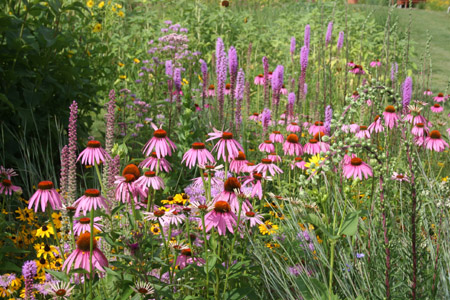My Cart: 0 item(s)
Garden Design Tips
|
Wildflowers and native grasses are a natural combination. The following ten tips combine the principles of plant ecology with those of traditional garden design. It is our hope that you will select the ideas that you wish to apply in your garden and express your own unique style! |

|
1) Plant Flowers and Grasses Together to create a natural meadow effect.The dense root systems of the grasses dominate the upper soil and help to squeeze out the weeds. The grasses essentially do most of the weeding for you, simply by eliminating open soil available for weed seed germination.2) Select Species to Match the Scale of your landscape.Use the shorter flowers and grasses in small meadow gardens. The short grasses, such as Little Bluestem, Sideoats Grama, and Prairie Dropseed are clump-formers that leave room between them for flowers. Most of the tall native grasses form a dense sod and do not always accommodate a diversity of flowers.3) Plant Deep-Rooted Wildflowers with the grasses.Many wildflowers have tremendously deep roots that can grow down 10 feet or more into the soil, well below the grasses root systems. The grasses and flowers thus share the soil rooting environment and utilize water and nutrients extremely efficiently.4) Plant Flowers in Masses and Drifts of colour to create impact in the garden.This technique can be very dramatic. We recommend mass plantings or drifts with a relatively non-competitive grass such as Sideoats Grama to help keep weeds down. Mass plantings of only one or two species of flower often experience weed problems. In a manicured or heavily-mulched garden, this may not be a concern.5) Arrange Plants to Complement one another, both texturally and in colour combinations.For instance, plant the flowering spikes of the blazingstars (Liatris) in front of the bold foliage of Prairie Dock. (Silphium terebinthinaceum). Most wildflowers mix well with the grasses, the green grass foliage serving as a background that highlights the flowers.6) Select Plants for Succession of Bloom throughout the growing season.This ensures that something interesting is always going on in your garden. Remember that the grasses will still provide a show in fall and winter when the flowers are gone.7) Tall Plants vs. Short Plants.Typically in garden design we are told "plant the tall plants at the back and the short plants at the front". This seems like a rather obvious principle to display and enjoy your plants. However, this is not how plants behave! The "tall" plants are plants that will mature and become tall by the autumn while the "short " plants tend to be spring or early summer bloomers. Most people tend to think that once the flowers are gone and the plant is going to seed, that the plants look "messy". This is often when we head out to the garden and "dead-head" the spent flowers in an attempt to clean up the garden. Instead of planting the "tall" plants at the back, think more of planting to create a low maintenance garden.If you plant the shorter plants towards the middle of your garden and plant later blooming plants around and in front of the shorter plants you will always be seeing what's in bloom now and also what's going to be blooming soon as the taller plants hide the shorter plants and you'll never have to see the spent flowers from earlier blooming plants! You'll get the benefit of always seeing whats about to bloom along with what is in bloom and you won't feel that you need to clean up or "dead-head' the spent flowers. This is a true low maintenance garden! 8) Include Spring Blooming Flowers in the garden.Many of the shorter, spring-bloomers are some of the most attractive and delicate of the wildflowers. Most spring wildflowers go dormant by mid-summer, thus making good companions for a variety of other flowers and grasses, tall or short.9) Use Large "Specimen" Plants as architectural focal pointsSurround individual specimen plants with lower-growing flowers and grasses to really help them show off their special attributes.10) Attract Songbirds, Pollinators and Butterflies with wildflowers.Wildflowers provide food and combined with the grasses, create habitat for wildlife, adding drama to your garden as these creatures go about their business. Early blooming flowers provide spring nectar for butterflies. Blazingstars and coneflowers are on the mid-summer menu, and asters and goldenrods sustain late season visitors. Silphiums, sunflowers, and grasses provide nutritious seeds for winter birds.By integrating the principles of ecology with those of garden design, you can create attractive, ecologically sound wildflower gardens. These gardens will require no fertilizers, pesticides or irrigation to keep them healthy and vibrant. Even during severe heat and drought, wildflower gardens continue to perform while other plants succumb to the weather. |
